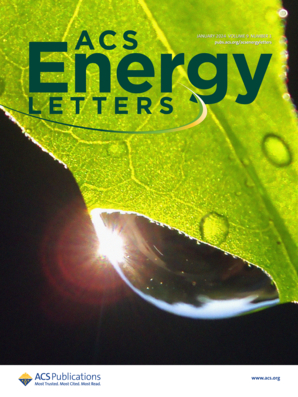Regulation of Electrostatic Shielding Effect by 18-Crown-6 Ether for Achieving Stable Deposition of Potassium Metal Anodes
IF 19.3
1区 材料科学
Q1 CHEMISTRY, PHYSICAL
引用次数: 0
Abstract
Potassium (K) metal stands out as a promising anode material for rechargeable K batteries, due to its low redox potential and high capacity. However, K-metal anodes suffer from interfacial instability in polar organic electrolytes alongside uncontrolled dendrite growth during electrodeposition. Herein, we propose an innovative approach for improving the stability of K-metal anodes. This involves incorporating 4 wt % of 18-crown-6 (18C6) as an additive in a carbonate-based electrolyte solution comprising 0.5 M potassium hexafluorophosphate dissolved in ethylene carbonate/diethyl carbonate. The key of this strategy is that 18C6 coordinates K+ into the cavity, forming a robust K+–18C6 complex. This complex exhibits higher reductive stability compared to other ion–solvent complexes in the electrolyte. During the plating reaction, this unique feature induces an electrostatic shielding effect, altering the transition of the K-deposition behavior from self-amplification to self-flattening. Consequently, it forms a stable solid electrolyte interphase, resulting in dendrite-free electrodeposition of K.

18-冠-6醚对金属钾阳极稳定沉积静电屏蔽效应的调控
金属钾(K)因其低氧化还原电位和高容量而成为一种很有前途的可充电K电池负极材料。然而,在电沉积过程中,k -金属阳极在极性有机电解质中受到界面不稳定以及不受控制的枝晶生长的影响。在此,我们提出了一种创新的方法来提高k金属阳极的稳定性。这包括将4wt %的18-冠-6 (18C6)作为添加剂加入到含有0.5 M六氟磷酸钾溶解在碳酸乙烯/碳酸二乙酯中的碳酸基电解质溶液中。这一策略的关键是18C6将K+协调到腔中,形成一个坚固的K+ -18C6配合物。与电解质中的其他离子溶剂配合物相比,该配合物表现出更高的还原稳定性。在电镀反应过程中,这种独特的特性引起了静电屏蔽效应,改变了k -沉积行为从自放大到自平坦的转变。从而形成稳定的固体电解质界面,形成无枝晶的K电沉积。
本文章由计算机程序翻译,如有差异,请以英文原文为准。
求助全文
约1分钟内获得全文
求助全文
来源期刊

ACS Energy Letters
Energy-Renewable Energy, Sustainability and the Environment
CiteScore
31.20
自引率
5.00%
发文量
469
审稿时长
1 months
期刊介绍:
ACS Energy Letters is a monthly journal that publishes papers reporting new scientific advances in energy research. The journal focuses on topics that are of interest to scientists working in the fundamental and applied sciences. Rapid publication is a central criterion for acceptance, and the journal is known for its quick publication times, with an average of 4-6 weeks from submission to web publication in As Soon As Publishable format.
ACS Energy Letters is ranked as the number one journal in the Web of Science Electrochemistry category. It also ranks within the top 10 journals for Physical Chemistry, Energy & Fuels, and Nanoscience & Nanotechnology.
The journal offers several types of articles, including Letters, Energy Express, Perspectives, Reviews, Editorials, Viewpoints and Energy Focus. Additionally, authors have the option to submit videos that summarize or support the information presented in a Perspective or Review article, which can be highlighted on the journal's website. ACS Energy Letters is abstracted and indexed in Chemical Abstracts Service/SciFinder, EBSCO-summon, PubMed, Web of Science, Scopus and Portico.
 求助内容:
求助内容: 应助结果提醒方式:
应助结果提醒方式:


